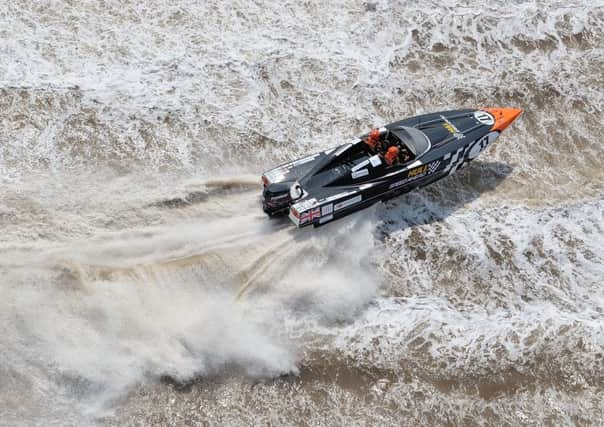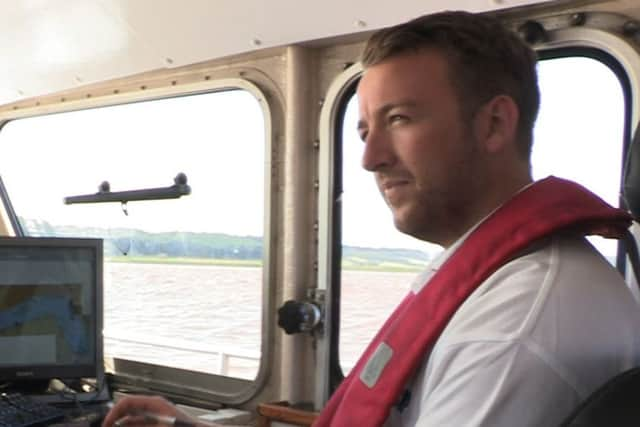Everyday stories of life on the Humber


ON the face of it Tom Humphreys’ job doesn’t sound overly exciting.
After all, not many people grow up wanting to be a hydrographic surveyor, and few probably know what one actually is. For those who aren’t aware it involves mapping geographical features on sea floors and coastlines and in Tom’s case it also involves following mud. Yes, mud.
Advertisement
Hide AdAdvertisement
Hide AdTom is one of a number of surveyors who monitor the ever-changing depths of the Humber Estuary. With around 40,000 commercial shipping movements each year, not to mention all the pleasure boats that chug up and down its channels, it is one of the busiest waterways in the UK.


With its fast-flowing currents, shifting sands and shallow waters, it is also regarded as one of the most dangerous navigable estuaries in the world, some say second only to the Orinoco in South America.
Tom returned to his home city three years ago to take up the position. “It’s a strange job in a way because nobody knows we exist,” he says.
Although perhaps not for much longer as Tom is among those featured in a new TV BBC documentary series – Sea Cities – which focuses on Britain’s city ports and how they have shaped people’s lives.
Advertisement
Hide AdAdvertisement
Hide AdThe five-part series, which started last week, charts the stories of people who live and work around Britain’s ports and rivers – doing everything from shipping cars to importing bananas. It also shows the crucial, but often overlooked, work carried out by engineers and riggers, skippers and pilots, fishermen and entrepreneurs.


On Friday, the spotlight falls on the Humber Estuary which for centuries has not only acted as a gateway to the continent but also as a crucial artery linking the rivers of Yorkshire and the East Midlands with the North Sea. Hull developed as a port from where wool, brought in from across the north of England, was exported to northern Europe.
It also became the focal point for the arrival of raw materials, including timber from the Baltic, that helped fuel our own industries.
Today the Humber Estuary is one of the fastest-growing trading areas in Europe and is crucial to British industry with nearly a quarter of our sea-borne trade passing through its muddy, churning waters.
Advertisement
Hide AdAdvertisement
Hide AdCargo is transferred from the docks at Hull, Grimsby, Immingham and Goole – the UK’s most inland port – and is then transferred to places like Nottingham and Selby.
For Tom, the programme is a chance to talk about the work he and his fellow surveyors carry out. “Sediment in the river moves all the time. It can change by up to a metre in just couple of days so we have to constantly measure the depth of the channels to make sure the bigger ships can travel down the river,” he says.
Ships’ pilots rely heavily on the work of those who chart and mark the shipping lanes in the shifting river bed. “We keep traffic on the river,” explains Tom. “The Met Office is integral to air traffic controllers because it keeps them informed of the wind direction and things like that, and we work in a similar way in a nautical sense.”
It’s an important task because if they get their measurements wrong then boats can end up hitting a sandbank. “The more cargo is loaded on board a ship the deeper it sits in the water and the more they can load on, the more money they make, so there’s a lot of pressure on us to get it right,” he says.
Advertisement
Hide AdAdvertisement
Hide Ad“Hull is dependant on the river but most people haven’t got a clue what goes on. I have friends who work as welders and farmers who are completely reliant on steel and farm feed being brought in that comes in on the river, but people don’t make the connection.”
Tom’s job means he comes across some unusual, and not always pleasant, sights. “I’ve seen dead dolphins and whales and even sheep which graze on the seaward side and get trapped when the tide comes in.”
For the most part, though, he enjoys what he does. “I’ve got one of the best jobs on the river – I get paid for going up and down the river in a speedboat. If anything goes wrong or something strange is spotted in the river then we get the call. We’re on the front line and we help to make it safe – we’re the first cog in the wheel.”
As well as its daily ferries to Zeebrugge and Rotterdam, the port of Hull also welcomes cruise ships five times a year and the TV cameras follow some of the dock workers who help out the passengers.
Advertisement
Hide AdAdvertisement
Hide AdThey all enjoy the challenge – whether it’s starting stalled cars, finding suitcases or helping elderly passengers up the gangway.
The people at Hughes Marine proudly declare themselves as “the dustmen of the docks”. The family-owned company founded by 66-year-old Barry Hughes is now run by his son Dean, and they fish out all the debris that busy docks accumulate.
Barry tried retirement but didn’t like it and is still working half a century after starting out. He’s been joined by his grandson Cory who is now the third generation to enter into the family business.
The estuary is home to all kinds of people from Kurt Christiansen, a Danish consul to Grimsby, to Guy Armstrong, a crane driver who is now looking to re-train. And while the Humber is primarily a working estuary it is also home to pleasure cruisers taking day trippers up and down the river, rowers and even powerboat racers.
Advertisement
Hide AdAdvertisement
Hide AdFor the past five years the P1 SuperStock championship has visited the Humber. The hugely popular speedboat competition sees boats reach speeds of up to 70 mph and among those that have taken part are best friends Dave Taft and Gavin Feldt. They started off racing together as driver and navigator in 2014, but last year they raced in rival boats in the Grand Prix of the Sea on the Humber Estuary.
Gavin, a semi-professional photographer and chauffeur by trade, had never set foot in a speedboat until two years ago. “It was a very steep learning curve for me because I was completely green, but now I’m an addict and I love it.”
As a local lad who grew up in the city he has seen the docks change over the years. “When I was a small lad me and my brother used to play on the King George Dock, although in those days there was a lot more manufacturing,” he says.
Now, having spent more time on the river, he appreciates just how important it is to Hull. “If you spend an hour up at Spurn Point you realise just how many ships come down the estuary,” he says.
Advertisement
Hide AdAdvertisement
Hide Ad“There are so many different jobs on the river, jobs that I didn’t even know existed. I take my hat off to all the people who work on the estuary because it isn’t an easy place to work. But you see how important the river is and how it links everything together.”
Sea Cities – The Humber Estuary, BBC Two, Friday at 7pm.
Changing face of the Humber
Ferries across the river can be traced back to the late 13th Century and have been crucial to the city’s trade links ever since.
However, industry in Hull changed after the Second World War. The smaller, older docks were closed, but Queen Elizabeth Dock opened in 1969 to handle container traffic.
The loss of the fishing industry, which collapsed in the 1970s after “the Cod Wars” with Iceland, hit Hull hard.
Advertisement
Hide AdAdvertisement
Hide AdHowever, many of the old industries which originally developed in the city to process imported raw materials are still there.
The port continues to thrive with some of the largest super-ferries in the world operating from the city.
It remains a major importer of timber from northern Europe.